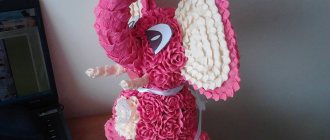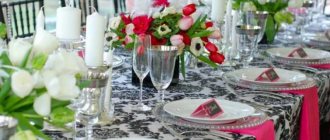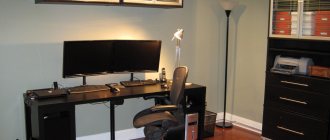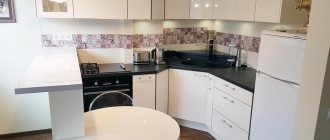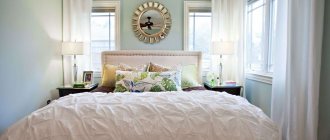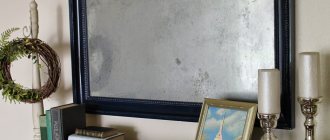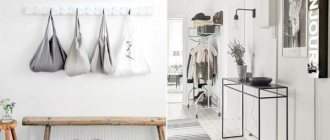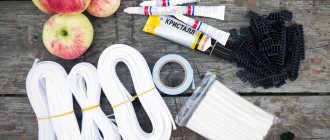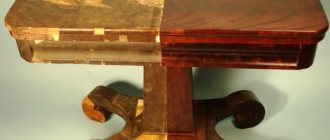3237
Every novice seamstress needs to properly organize her workplace. To do this, you will need a sewing table, which you can make yourself. Having a specialized workplace will allow you to work with greater comfort and save time. In addition, having his own corner, the master will not disturb the family, and all the tools will be stored in one place.
How to make your own sewing table
Specialized sewing tables are presented in a fairly small assortment, and their cost is often comparable or even higher than the price of the machine itself.
Professional sewing tables can be very expensive. Therefore, making a table for a sewing machine with your own hands is a good alternative. Moreover, you don’t need to have any talents to do this.
You can try to make such a table yourself with your own hands.
Drawing
First you need to design the future product, for this you will need a drawing. Discuss with its future owner the type of structure, its dimensions, and whether additional compartments may be required.
Before you start drawing, consider the final appearance of the table. There are the following types of sewing tables:
- cabinet with sections for storage;
- table-book with space for a typewriter;
- with folding tabletop;
- transformable corner table.
Ideally, the table should have room for a machine, an overlocker, and the ability to make a pattern.
Material selection
To realize your idea, you can use materials such as chipboard, MDF, plywood or solid wood. Chipboard and MDF are afraid of water and are susceptible to rotting. In products made from them, fastenings, screws and nails gradually become loose, which is why the furniture is short-lived.
The best options for making such a table are plywood and wood. Plywood and wood are the best option, as they are durable, which increases their service life. In addition, they are environmentally friendly.
Step by step assembly
After you have received the drawing and purchased the necessary materials, you can begin work:
- cut out the parts according to the drawing;
- mark the parts and drill holes;
- sand the edges of the parts or glue them with edge tape;
- Next, the main stand for the sewing machine must be assembled with your own hands;
- attach the tabletop;
- attach folding surfaces, an additional bedside table, or even several (if desired);
- coat the product with varnish;
- after the varnish has dried, assemble and screw the drawers and shelves;
- install the doors;
- screw furniture handles.
After the table is finished, all that remains is to install it in a pre-prepared place. All that remains is to install the finished product in a place in the house prepared in advance for it.
Manufacturing materials
When constantly using furniture for sewing, the material from which it is assembled is not least important. Getting to know the characteristics of wood, chipboard, MDF will help you make the right choice:
- The wooden table is durable and highly wear-resistant. The noble surface texture will organically fit into the interior of any style. The peculiarity of such a product for machine sewing is that the design can be improved independently (add modules, shelves). Disadvantage: high cost, significant weight.
- MDF is lightweight, easy to process, and affordable. You can assemble a table of the desired design yourself from components (tabletops, side racks, metal fittings) ordered from a furniture company. Craftswomen appreciate comfortable and lightweight mobile furniture mounted on wheels. The disadvantage of MDF is its sensitivity to moisture and elevated temperatures (it is not recommended to work with steam or a hot iron on such a coating).
- Chipboard is a budget option. The advantages of the products are a large selection of models, light weight. The disadvantages of the material are sensitivity to moisture and high temperature. A folding table made of chipboard has a limited service life.
Types of bed tables, their features and functionality
The table top is the most important part of the cutting table. All needlewomen know that working comfortably with fabric and scissors is possible only on a smooth surface. But you also need to take into account that thin fabrics (chiffon, silk, organza) will easily slide off it, so the surface should be a little rough. As an option, the table is covered with a piece of linoleum.
With intensive work, the surface of the furniture quickly wears out. Therefore, a professional cutting table is sometimes covered with a countertop made of artificial stone.
Wood
From chipboard
From MDF
Convenient sewing table
|
Height and dimensions of a sewing table Before you buy or make a sewing table yourself, measure how much space you plan to allocate for the work area in which you plan to sew. Remember that there should also be an ironing board and some drawers or boxes for fabrics and auxiliary materials. The size of the tabletop , naturally, must fit into the area that it was decided to allocate for the desktop. There are a lot of tables for sewing machines on sale now, so when you go shopping, first find out the height and dimensions to suit your needs. The minimum size of the tabletop is the dimensions of a cabinet for a sewing machine - width 45 cm, length when unfolded 114 cm. But, if you decide not only to sew, but also to cut on this table, remember that the width of the fabric folded in half lengthwise is 70- 75 cm. Maybe it makes sense to base the table width on this size, and choose the length based on the size of the working area
|
|
Configuration of tables for sewing A work place for sewing is not only a table for a sewing machine, it is also a lot of different ribbons, tools, fabrics, duplicating materials, spools of thread and many other “little things”. And you also need to find a place on your desktop to store them, otherwise constant clutter around the sewing machine is guaranteed. Let's look at a few examples of how workplaces with a sewing table are organized at home.
Table-book Work area from Kalita . The tabletop can be attached to the cabinet shelf using hinges. We screw sockets to the underside of the tabletop; ready-made legs can be easily inserted and removed into them. Helmer cabinets, which can be bought at IKEA, can be rolled closer to you with the table top raised, and after finishing work, rolled deep and covered with the lowered tabletop. The cabinet drawers will hold everything you need, and unfinished projects and fabric cuts can be stored in the closet, which is included in the common work area.
Folding table-pedestal You can place the entire workplace in one cabinet, the dimensions of which are 112.5 x 60.2 x 77 cm. Forum member AsyaMinulina tells in detail, with dimensions and drawings, how to make it.
Corner table If the plans do not include disguising the table, you have more than one sewing machine and space allows, you can make a corner table. The drawers can hold many small items needed for sewing.
The article was prepared based on materials from the forum topic Work Corner! Model of a work table.
You can select and order over 6,000 types of fabrics in the Season online fabric store. By clicking on the preview with a sample, you will be taken to the desired department of the store. The price will pleasantly surprise you: it is less than in a real store.
